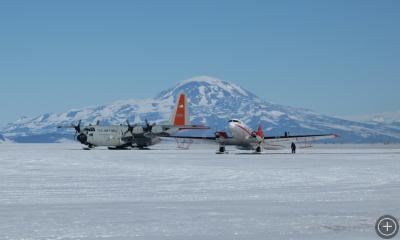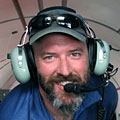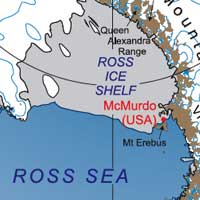Back to the Future: Meet our Flying Laboratory
MCMURDO STATION, ANTARCTICA– Imagine it’s 1942 and you are a pilot ferrying a brand new Douglas C-47 twin-engine airplane from the factory in sunny Santa Monica, California to England to support the Royal Air Force’s efforts to stop Hitler. The ongoing war is about the only thing on your mind. What if someone told you that 67 years later this same exact airplane, having survived WWII and 6 more decades without a major mishap would become a high-tech flying laboratory with a comprehensive suite of state-of-the-art geophysical instruments? And what if they told you this flying lab would be conducting 8-hour survey flights far into the interior of Antarctica, the ice-covered continent at the south pole? I bet it would sound like science fiction, pure fantasy. But that is exactly what happened. Let me tell you why and how.
Enter the past: The DC-3, or C-47 military variant, is intermediate in size and range between the Hercules and Twin Otter, and is one of the few types of aircraft that can be fitted with skis. The first plane to land at the south pole was a C-47. However, all of the existing airframes are very old and not suitable for sustained operations of the type we need for scientific exploration. Fortunately, a company in Wisconsin gives these airplanes a second life by completely restoring them from the bare frame, adding more powerful and safe turbine engines, new electrical and fuel systems, flight instruments, you name it. They even lengthen the fuselage by over a meter. The airplanes are essentially new when they roll out of the facility.
Our project saw the need for such an aircraft and undertook the modification of one to conduct long-range airborne surveys in Antarctica and Greenland. Last season in Antarctica we proved its capability by surveying a vast, largely unknown part of East Antarctica using fuel and facilities at the coastal stations of McMurdo (US), Casey (Australia), and Dumont d’Urville (France). We made two stops at Concordia Station (French/Italian) in the interior and obtained about two dozen barrels of fuel there, but that was the only interior resource we used. We were also able to pack up and move ourselves between these stations while conducting surveys along the way. This is a first, and has opened the door to a new era of Antarctic exploration.
I have included some video of our unique aircraft and team members in action. In the next installment I’ll explain a bit about radar and show you some data that we’ve acquired here, since that provides the first and best picture of what is below the ice. Stay tuned.
Get the Flash Player to see this player.












Very cool video !!
Look forward to reading more on the blog!!
Ann Mishmash
NIce views over the Antarctica range.. I remember flying from Amundsen-Scott to Mac Murdo through the Dry Valleys , back in 1977, before being flown to Dome Charlie where the Concordia base is today.
Normally you should have got more than two dozen barrels of fuel at Concordia.. The cooks there, either French or Italian, have to stand up for their reputation.
And the drinks are not too bad either. Unless they changed the rules since I was there.
Thierry – the food is still excellent at Dome Charlie, and the camp is amazing (and wine on the dinner table!) It’s always fun to stop there, and it’s so well located for our work… Neat to hear about your visit there back then.
Thanks for reading, Ann!